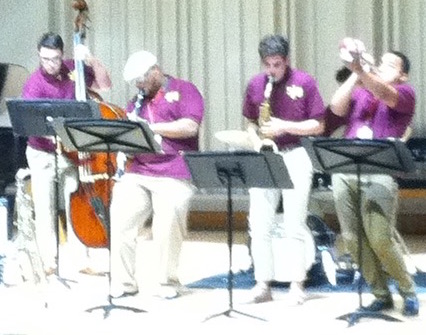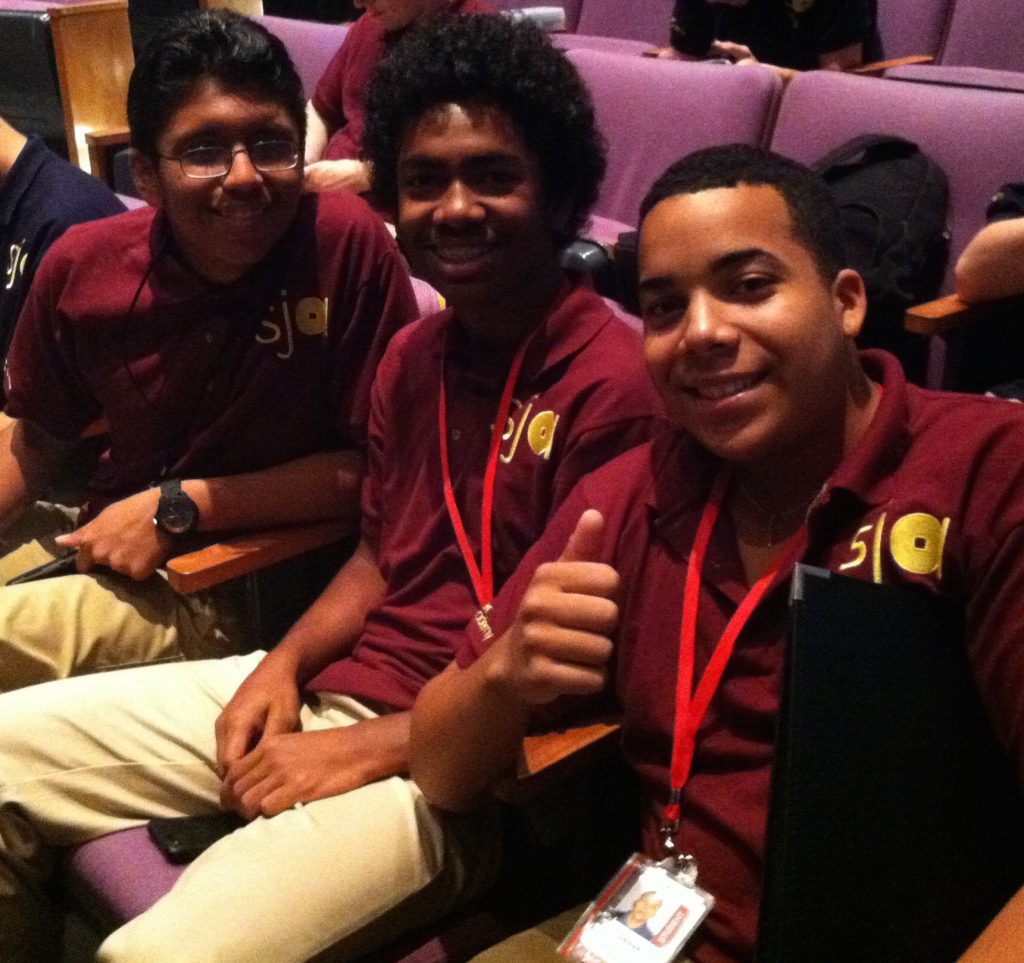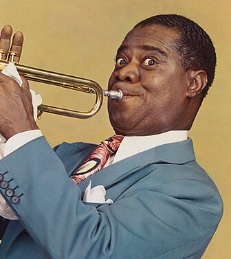Afro-Cuban culture, Blog, Cuba, Cuban Jazz, Latin Jazz, The Cuba-US connection, Video and audio
The clip starts out with the recollections of two Palladium Ballroom dancers. Then we go into a short film made about the place in 1955.
Some perspective for younger people:
1. Film was still an expensive and unwieldy technology back in the 1950s so rough as this footage is, it’s great someone made this film of the place in its prime.
2. If everyone looks overly dressed up, this is how people put themselves together in those days when they went out. The jeans and t-shirt, ditch-digger-on-a-break look was still a decade away.
What was the Palladium Ballroom?
Like CBGBs for punk rock and the Birdland for bebop, the Palladium was THE place for Latin music in New York City in the 1950s.
It was a second-floor dance hall at the corner of 53rd Street and it was huge. It could fit one thousand dancing couples.
How it started
Latin orchestras shared the bill with mainstream jazz orchestras throughout New York City in the 40s and 50s, but “Latin” places were all uptown in Spanish Harlem and the Bronx.
In 1948, event promoter Federico Pagani approached the Palladium’s owners Max and Helen Hyman with an idea to bring new energy to the place which at that point was in commercial decline.
The idea was a Sunday matinee featuring Latin music exclusively. At that time, this was the first club to try this “downtown.”
From the opening night, it was a huge success with dancers, but there was an initial glitch. Max Hyman was worried about the number of black and Latino dancers who were showing up.
While New York did not have the same kind of Jim Crow laws of the south, there was an informal segregation especially downtown.
Pagani reportedly said to Hyman words to the effect: “What do you care more about black or green?”
Hyman chose the green and New York City’s (perhaps America’s) fully first integrated dance hall came into being and Latin music took over the Palladium seven days a week.
What it was like
The music was non-stop and off-the-hook starting with the orchestras of the “Big Three”: Machito, Tito Rodríguez, and Tito Puente.
Arsenio Rodríguez performed there as did Celia Cruz, Beny Moré, Pérez Prado, La Lupe, and countless others.
Mass dance classes were given to the crowds that attended.
Jazz cats loved the place and sometimes sat in with the featured bands.
A short list of those seen there: Dizzy Gillespie, George Shearing, Cal Tjader, Buddy Rich, Count Basie, Duke Ellington, Billie Holiday, Ella Fitzgerald, Gene Krupa, Dave Brubeck. Paul Desmond and Joe Morello.
Celebrities loved it too: Marlon Brando, who occasionally sat in on bongos; Sammy Davis, Jr., Frank Sinatra, Dean Martin, Peter Lawford, George Hamilton and Jerry Lewis.
The only people who didn’t like it were the top brass at the NYPD who, in their role as the scourge of black culture in NYC, harassed the place constantly.
A huge drug raid in 1961 led to the Palladium losing its liquor license, a financially crippling blow. That and cultural shifts brought in by rock and roll led the its closing in 1966.
The feature length film, The Mambo Kings, recreates the Palladium’s golden years Hollywood style.
Bronx-born Orlando Marin, a Palladium orchestra leader still performs regularly in the New York City area. If you get a chance to see him, do not miss it.
– Ken McCarthy
Jazz on the Tube
P.S. Our unique programming is made possible by help from people like you. Learn how you can contribute to our efforts here: Support Jazz on the Tube
Thanks.
Afro-Cuban culture, Blog, Cuba, Cuban Jazz, Latin Jazz, The Cuba-US connection, Video and audio
TamboThe exact origin of Machito (Francisco Raúl Gutiérrez Grillo) is a bit of mystery.
Where and when he was be born isn’t clear. Some scholars say he was born in Tampa. Others day Havana. Some put the year at 1909, others say 1912. Still others day 1915.
What isn’t a mystery is that he was raised in the Jesús María district of Havana and his foster sister Graciela (featured below) was born August 23, 1915.
What also isn’t a mystery is the impact he and his band had on world music.
Like so many accomplished musicians of that era, Machito moved to New York City (in his case in 1937) to take advantage of the opportunities in the Big Apple.
In 1940, he started his own orchestra The Afro-Cubans, one of the most important units in jazz and Cuban music history.
First, the band’s name: The Afro-Cubans.
This was a radical name for the time.
From a perspective, the term “Afro-American” was not accepted as common usage by the New York Times until 1990. So Machito and his musicians were fifty years ahead of the social curve.
Racism and the accompanying failure to acknowledge the power and virtue of African culture was as common and virulent in the Cuba of the 1930s as it was in the US.
Calling his band The Afro-Cubans was the 1940 equivalent of “We’re black and we’re proud” at a time when making such statements were rare at best and dangerous as worst.
Second, Machito’s orchestra was extraordinary by every conceivable standard and moved the art forward not only for Cuban music but for American jazz as well.
Though Dizzy Gillespie is rightly credited with helping the cause of Latin music in the US jazz world, “Manteca” wasn’t recorded until 1947 and New York City jazz musicians had been digging Machito’s music for years by then.
Also, the introduction of Dizzy Gillespie and Chano Pozo was made by another giant of Cuban music, the incomparable Mario Bauzá who was Machito’s musical partner and music director.
We’re just scratching the surface here (as we do with all these brief profiles.)
Start with these clips and dig deeper with your own research and you’ll surely be richly rewarded.
Tanga (with Zoot Sims on tenor and Symphony Sid announcing)
Machito & Graciela in Japan, 1960s– Ken McCarthy
Jazz on the Tube
P.S. Our unique programming is made possible by help from people like you. Learn how you can contribute to our efforts here: Support Jazz on the Tube
Thanks.
Blog, Cuba, Cuban Jazz, Latin Jazz, The Cuba-US connection

Right to left: Jesús Ricardo (trumpet) with Hector Gagnet and Craig Jackson (both from Dayton, Ohio) and Philip Norris on bass (Wake Forest, NC.)
Will jazz survive?
The answer to this question, which lives in the hearts of all serious jazz fans, depends on two things:
Will the new generations embrace the music?
Will the established generations give the younger guys and gals a hand up?
Here’s the story of one young man’s path
Jesús Ricardo grew up in the Vedado district of Havana, Cuba.
He got his first exposure to music education when his fourth grade teacher suggested to his father that Jesús abundant energy, then used to beat rhythms on his school desk and other surfaces, might be more constructively channeled in a music program for kids. His father, a non-musician, said: “Sure, let’s give it a try.”
The focus of the training was classical, as is all institutional music education in Cuba, but the school also had as an elective a jazz big band. Hearing the band opened Jesús ears and captured his imagination. In jazz, he heard a music that would allow him not just to play, but to also express himself.
Bringing the US jazz tradition to Cuba
When he was in seventh grade, Jazz at Lincoln Center and Horns to Havana brought instructors to the island for performances and workshops. Jesús was one of the students who received training from Wynton Marsalis, Victor Goines, and Mike Rodriguez.
Students in the program were invited to sing solos and Jesús stood up and gave it a try. He along with the other students were encouraged to get that same singing feel with their instruments. When the Jazz at Lincoln Center group performed at Havana’s Teatro Nacional, Jesus was invited to come on stage and take a trumpet solo on Night in Tunisia.
In the ninth grade, Horns to Havana arranged for Jesús to spend a month in New Orleans.
Last year with help from Horns to Havana, he attended the Stanford Jazz Workshop and this summer he qualified for Jazz at Lincoln Center’s Summer Jazz Academy.
Jazz at Lincoln Center’s Summer Jazz Academy
Designed by Wynton Marsalis, who is also one of the instructors, and led by Dr. Michael Albaugh, the Academy is a two week residential program which this year was held on the campus of Bard College.
This year’s faculty included Wynton Marsalis (trumpet), Marcus Printup (trumpet), Ted Nash (saxophone, flute), Vincent Gardner (trombone), Helen Sung (piano), James Chirillo (guitar), Rodney Whitaker (bass) and Ali Jackson (drums).
(If any of these names are unfamiliar to you, get thee to Youtube, Spotify and/or the iTunes store and dig in. You won’t be disappointed. The faculty played a set as an octet and individually and as a group they were splendid.)
The program is open by audition to high school jazz students from all over the world. Only only 42 are accepted.
In addition to his growing jazz chops, Jesús is at home in Cuban idioms like Son, Guaracha and Rumba and draws inspiration from the music of Cuban trumpet greats like Chapotin and Florecita. He’s performed with the Septeto Habanero, an esteemed interpreter of the island’s classic Son repertoire.
A serious student of the tradition
When I asked Jesús who his favorite trumpet player was, he responded: “All of them. There’s something important to learn from all of them.”
As part of their training, the students worked in small groups – eight different octets in total – and at the end of Week One they offered a public performance of standards ranging from George and Ira Gershwin to Ornette Coleman.
The octet Jesús played with was tasked with King Oliver’s “Dippermouth Blues.” At first he says he worked the changes like a bebopper until Marsalis, who coached the unit, explained Oliver’s syncopated style which had been perfected by countless parades and funerals.
With Marsalis’ guidance, Jesús adapted and you could hear – and even see – the New Orleans flowing through him as he marched in place when he took his solo.
Will jazz survive?
At the start of this article I said that the answer to this question depends on two things: the younger generation’s interest and the established generation’s caring.
Things seem to be on the right track in both these departments.
If you want to learn more about groups that are helping make the next generation of jazz possible, here are two excellent places to start.
Horns to Havana
http://hornstohavana.org
Jazz at Lincoln Center
http://www.jazz.org

Jesús (right) with fellow students at the Lincoln Center Summer Jazz Academy
– Ken McCarthy
Jazz on the Tube
P.S. Our unique programming is made possible by help from people like you. Learn how you can contribute to our efforts here: Support Jazz on the Tube
Thanks.
Afro-Cuban culture, Blog, Cuba, Cuban Jazz, Latin Jazz, The Cuba-US connection, Video and audio
From the point of view of record sales “Manteca”, composed in collaboration with Cuban percussionist and composer Chano Pozo (1915-1948), was Dizzy Gillespie’s greatest hit.
Though it was not the first fusion of jazz and Cuban music, it was the first to have a nationwide impact on US jazz musicians and it opened the floodgates to all sorts of jazz/latin collaborations and experimentation that are continuing to this day
Click here to learn more about Chano Pozo.
– Ken McCarthy
Jazz on the Tube
P.S. Our unique programming is made possible by help from people like you. Learn how you can contribute to our efforts here: Support Jazz on the Tube
Thanks.
Afro-Cuban culture, Blog, Cuba, The Cuba-US connection, Video and audio
Robert Farris Thompson: Doctor of Soul
Robert Farris Thompson likes to call himself a “mambologist.”
This may be too technical a term for the layman, so let me suggest another title for him: Doctor of Soul.
Doctor because anyone with a PhD has the right to call himself that.
Doctor because the word comes from the Latin word “to teach” and Thompson is nothing if not a master teacher.
Doctor also means someone involved in the process of healing and it’s this third meaning, I want to focus on.
When Thompson came into the world in the Anglo community of El Paso, Texas of 1932, the idea of studying African culture and its popular manifestations in the Americas with respect did not exist in academia or in the dominant culture at large.
His career has been a decades long process of healing this cruel ignorance.
Thompson’s story…
Living so close to the border of Mexico, even as a child he appreciated the profound difference crossing a border can make.
Then at 18 on a trip to Mexico City with his family lightening stuck: He heard a Cuban band playing mambo.
Mambo is a music. Mambo is also an approach to life.
Digging deeply into this philosophy has been the focus of Thompson’s life and his path breaking studies have literally changed the world.
Now people who care to be educated can see that Africa is not “a primitive place over there”, but the fountain of a deep aesthetic and ethical culture that is at the root of much of what is best about the Americas.
That Thompson managed to start his monumental work inside of a university in the 1950s is a demonstration of mambo itself. No career or course of study could have been more far-fetched in those narrow minded, culturally ignorant times.
If you’re at all interested in black culture and black culture in the Americas. I urge you to watch all the videos.
All I can add is that it’s a shame that so few of his “performances” (they go far beyond lectures) have been recorded and made available to the public.
They’re among the greatest intellectual and cultural gems produced anywhere by anyone in the last 50 years.
“We can’t know how American we are unless we know how black we are.” – Robert Farris Thompson
Interview with Robert Farris Thompson
Robert Farris Thompson on Jose Bedia
The Afro-Argentine Legacy of Tango
In addition, to the videos on this page – every single one of them is a revelation and must-watching for anyone who loves music and black culture – this short article is a good introduction to him.
– Ken McCarthy
Jazz on the Tube
P.S. Our unique programming is made possible by help from people like you. Learn how you can contribute to our efforts here: Support Jazz on the Tube
Thanks.
Afro-Cuban culture, Blog, Cuba, Cuban Jazz, Latin Jazz, The Cuba-US connection, Video and audio
Cándido de Guerra Camero (“Candido”) was born April 22, 1921 in Cuba.
At the time of this writing (June 22, 2016) you can still see him perform.
If you get the chance, do not miss it.
At 95, he needs a little help to get to his seat and drums, but from the first slap the power resonates from him and fills the room.
In the 1940s like so many Cuban music masters he moved to New York City where he has had an incalculable influence on the world of percussion and in fact is the most recorded conga drummer in the history of jazz.
Candido shows his prowess on the bass and the cowbell. No one sets a better groove!
Candido swings with some young cats…
The band is Unity. Recorded by Congahead .
Candido Camero-conga
Axel Laugart-keyboard
Amaury Acosta-drums
Max Cudworth-alto sax
Mike Rodriguez-trumpet
Chris Smith-bass
Michael Valeanu-guitar
Mauricio Herrera-percussion
Composed by- Candido Camero
Arranged by Amaury Acosta/Mike Rodriguez
– Ken McCarthy
Jazz on the Tube
P.S. Our unique programming is made possible by help from people like you. Learn how you can contribute to our efforts here: Support Jazz on the Tube
Thanks.




 Louis Armstrong
Louis Armstrong